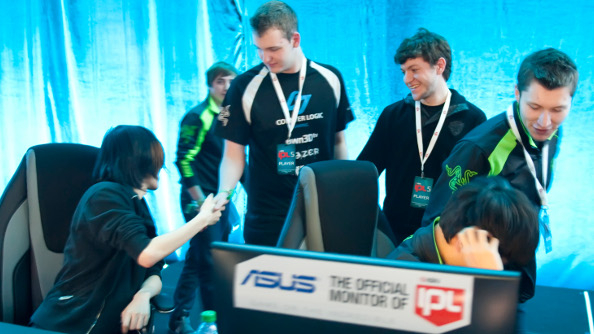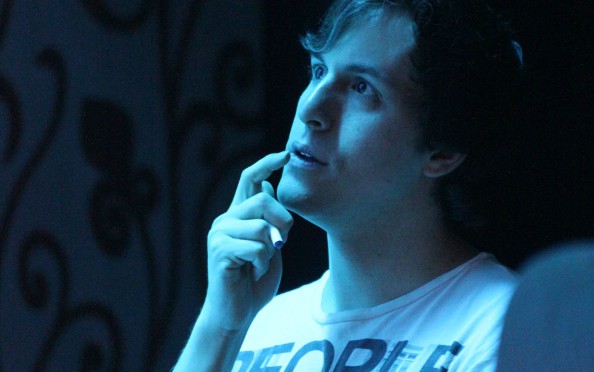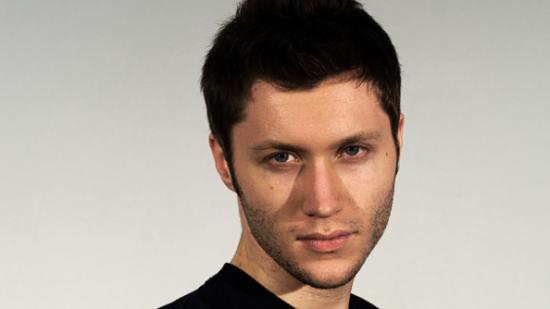Evil Geniuses CEO Alex Garfield wasn’t posturing when he talked about his disinterest in taking the Evil Geniuses eSports team into League of Legends. He was so unengaged with League that when he received an email from Stephen “Snoopeh” Ellis last summer, he didn’t really know who Ellis was, or why Evil Geniuses should be interested in his League of Legends team.
A few minutes with Google not only told Garfield that Ellis was the squad captain for one of the best and most prominent western League of Legends teams, but that suddenly he had a “very attractive opportunity” to bring EG into League on terms he could be happy with.
Roughly six months later, Ellis and his squad are wearing EG blue and fighting for the lead of the European division of Riot’s League of Legends Championship Series. But the story of how EG overcame their reluctance towards League, and why EG made the most sense for Ellis and his team is one that reveals a great deal about what deal-making looks like at the elite level of eSports. We recently had a long chat with both Garfield and Ellis about their negotiations, and the reservations they had to overcome before they could join forces.
Outgrowing CLG
Counter Logic Gaming is one of the biggest names League of Legends, and last year they operated both a highly-regarded North American squad and adopted a new European team comprised of Ellis (Jungle), Henrik “Froggen” Hansen (AP), Mike “Wickd” Petersen (Top), Peter “Yellowpete” Wüppen (AD), and Mitch “Krepo” Voorspoels (support).
But in no time at all, the European squad began outperforming its sister team and, more importantly, Ellis began to feel that two major League squads might be too much for one team.
“We [were] actively looking for someone else to join because CLG was struggling to support essentially two of the biggest teams in LoL,” Ellis explained. “We caught wind that EG was looking at a LoL team, and I just made the introduction.”
His approach to EG CEO Alex Garfield stood out for its professionalism and maturity. They were the two traits, Garfield admitted, that he found most lacking in the League professional community.
If you’re just jumping into League of Legends and want to know what champions to pick, check out ourbest League of Legends champions for beginners guide.

“When I was scouting potential players and teams for EG League of Legends, I felt like I saw a lot of shock value behind some of the more popular guys. Especially like a year or more ago,” Garfield said. “So for me it’s not just about is there popularity behind this particular guy or this particular team, but what kind of identity is there? It takes time for a playerbase and community to mature before there can be massive popularity behind a team that doesn’t need any shock value or hook.”
Garfield stressed that he doesn’t look down on the LoL community or its players. He cites SoloMid as an example of a strong team that has a different approach from EG.
He said, “I have had a lot of respect for the SoloMid team for awhile. They were never the right fit for me, [but] I feel like it’s a very casual kind of identity. I can totally see what someone watching Dyrus stream, for example, can connect with him. But at the same time, I think behind EG, behind our signings, there’s a lot of prestige. A little bit of gravitas, I would like to think.”
Courtship and sponsorship
Evil Geniuses were just one of a few options Ellis and his team were considering during 2012, including independence. Ellis been allowed a lot of freedom at CLG and had gotten to know a number of sponsors and partner organizations. He thought that if his team struck out on their own, he might be able to manage them successfully without being involved with another organization. But he didn’t like the risk, and he didn’t feel completely confident that he was ready to navigate those waters.
But as he considered his options and conducted preliminary conversations with Garfield, the two sides were pushed closer together by Razer and its director of eSports, Chris Mitchell.
Razer are one of the most prolific sponsors in eSports, and their equipment is some of the most recognizable high-performance gear in PC gaming. As part of their eSports program, Razer also do significant player outreach and support. When you’re a Razer-sponsored player at a foreign tournament, Ellis explained, and you discover vital equipment has been left behind somewhere along the line, you can usually trust that someone from Razer is going to show up on short notice with an exact replacement.
The personal touch mattered to Ellis and his team. Razer named the CLG EU squad its team of the year in 2012, and Ellis had gotten to know Mitchell a bit during his time with CLG. He noticed the difference between them and some of the other sponsor representatives he’d dealt with: Mitchell and Razer were personable and passionate, less guarded than other reps. They were people Ellis felt he could trust.
At the same time, Razer and Evil Geniuses were also in their own negotiations, and Razer urged Garfield to take a close look at Ellis and his team.
“It’s not like the kind of thing where we needed this to happen to get the deal, but they really pushed us to consider it,” Garfield said. “They do trust us to build our own talent portfolio. We would have been fine with no league of Legends presence, but Chris in particular was really like, ‘You should really try to get these guys if you can.’”
Dividing the streams
Esports contracts are a bit more involved than they used to be. Where teams used to live and die by sponsorships and, to a lesser extent, tournament placement, streaming revenue has completely changed the business model. Ellis said that top players can make upwards of between five and eight thousand pounds a month through streaming revenue.
The numbers have become even more impressive through Riot’s tournaments. The World Playoffs last year gave the top teams a ton of additional exposure, and now the LCS Season 3 format has given similar prominence to a ton of new teams. While Riot spends about $175,000 subsidizing each League team and its player salaries, the real wealth of the LCS is exposure.
It’s not a revenue stream team organizations can ignore. One of the places where Ellis and Garfield ended up going back and forth in negotiations was the exact revenue split between EG and the individual players for their streams, and how much time they would be obliged to spend streaming.
While EG don’t comment on player salaries or revenue splits, they pride themselves on placing as few burdens on their players as possible.

“Our stream take was the lowest of all [offers] and our minimum requirement for streaming hours was tied for the lowest. So in terms of prize money take, streaming revenue take, and streaming hours in general, we tend to be the most appealing to players,” Garfield said. “Our prize money take is 10 percent or lower. Whereas a lot of traditional eSports organizations its around 20 and sometimes 30 percent. So our take of the LoL stream revenue was very fair to them in the context of other teams.”
One reason Garfield tends not to fight too hard for more streaming revenue is that such a large portion of its value lies in the data it generates. Much of the eSports business takes place in the dark, with stakeholders relying on guesswork and intuition rather than empirical data. It’s a sharp contrast, Garfield says, from the way traditional sports work.
“Athletic sponsorships are audited even more closely in terms of numbers than eSports sponsorships,” he said. “There’s a certain amount of limited internal transparency about TV ratings and exposure, and players have access to that, and agents and sports marketing firms have access to that. So they can pair a particular player to a particular brand, and the brand can can track the kind of exposure they’re getting by sponsoring the player.”
Esports have no comparable infrastructure, which can make it very hard to support a team or make a case to sponsors about what their money is buying them. Not that long ago, the coach of the renowned LG-IM StarCraft team posted to TeamLiquid requesting that fans contact LG and tell them they appreciate their sponsorship and that it has made them more disposed to use LG products. This is not the kind of thing that inspires confidence in the business model.
“One of the reasons that it is so hard, if not impossible, to get money from companies strictly to put their logo on your shirt is that we have none of that [infrastructure]. MLG is not forthcoming with its broadcast analytics to me,” Garfield said. “There is no unified database. You have NOTHING to sell in that regard. And that’s why livestreaming is so important. It’s a number you have control over.”
“…Now we must make Italians.”
While the two sides were able to come to an agreement around the terms Garfield outlined, it is still a very young partnership. Ellis and his team are under contract to EG through this year, and he has not entirely ruled out eventually going independent. Joining EG has already required some adjustments for Ellis, who was used to CLG’s laid-back approach.
“One of my concerns when I joined EG,” Ellis said, “was that it might be a little too stringent or restrictive. Because there’s so much sponsorship consciousness, they want the brands represented a certain way. And that’s one of the things we have to kind of balance. You don’t want to see pictures of me naked, hugging Froggen, for example. That’s funny when we were CLG and we might have gotten away with it, but now we’re part of EG. That’s definitely not going to fly and we’ve got to be a lot more careful with things that are being put out there to manage sponsorship relations.”
There is another issue: while EG now have a League of Legends team, that group has such a strong identity that it exists apart from EG and their former team, CLG. Whether or not they were EG, they would still be the same team. It’s the kind of question you might find in an intro philosophy course at college, but branding hinges on these phenomenological questions.
Garfield insists that EG is more than a collection of sponsorships and players, but it would also be very easy to see EG as a kind of glorified eSports middleman. He’s aware of that perception and tries to guard against it, but he understands where it comes from.
“They don’t do that for no reason. It takes a certain amount of time to build a brand affiliation that’s more than us paying them for a year,” Garfield admitted.
What Garfield wants is time. He knows that Ellis may still want to pursue an independent path in the future, and that, for the moment, people may see the LoL squad less as an EG team and more a team wearing EG uniforms. Integrating the two will take time, both in the minds of the public and in the relationship between EG and its five League stars.
“I think our contract term is for a year, and Stephen and I had many conversations and are very clear with each other about the team’s long term thoughts, their different options,” Garfield said. “From the players’ perspective, they’re going to keep the option of going independent. But from my perspective, I think that if I want to keep these guys, and I can keep them happy, I’ll be able to keep them. And make this the most attractive option. After a certain amount of time, people will stop looking at EG as a temporary fix, or just a sponsor. And see it as an actual team.”
